The world around us is both beautiful and inspiring, but sometimes it can also be a little bit frightening. The power of nature is mightier than all of us, and as incredible as it is to behold, sometimes we find ourselves standing in its way and completely at its mercy.
The strongest person in the world can do nothing in the face of a hurricane. The greatest swimmer is defenseless when caught in the middle of a flood. When Mother Nature truly wants to flex her muscles, she demonstrates that the planet is still hers; we just live on it!
But there are kinder sights to be seen, too. The animals living on our planet can be fierce, cute, cuddly or downright bizarre. When they are, it's useful to have a camera to hand. Here are fifty incredible pictures captured by people in the right place at the right time.
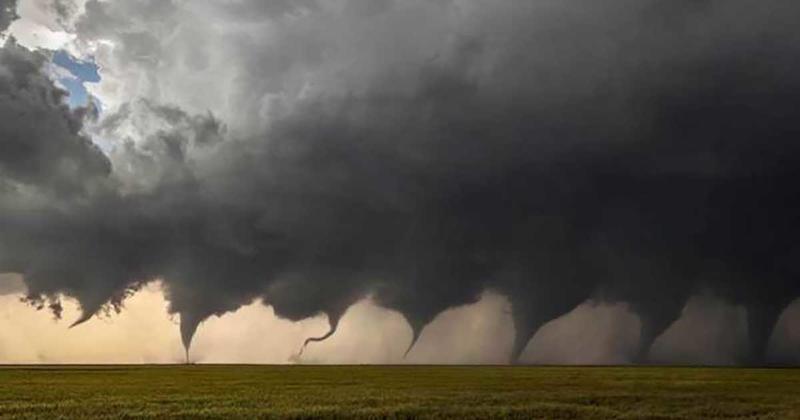
This photo, taken by Jean Guichard, initially looks like a painting. The situation captured in it seems so improbable that you'd naturally assume it was a work of fiction. But it isn't, it's completely real. The lighthouse surrounded by walls of water is the Phares dans la Tempete, sitting just off the coast of Brittany in France, and the storm closing in around it is every bit as dangerous as it seems.

Ironically, the name of the lighthouse translates into English as 'Lighthouse in the storm', so you could argue that whoever named it was asking for trouble! Although the man standing in the doorway looks perfectly calm, that's actually lighthouse keeper Theodore Malgorne trying to attract the attention of rescuers. He has a full crew inside the lighthouse, also needing help. The picture was taken in 1989; long before the age of Photoshop.
This is a classic scenario from a horror movie; you're camping in the wild, it's late at night, and you hear mysterious noises outside your tent. Who could it possibly be? You're miles from civilization, and you're all alone. Would you be brave enough to open the tent up and peek outside? The woman who took this picture was, and this was the sight that awaited her!
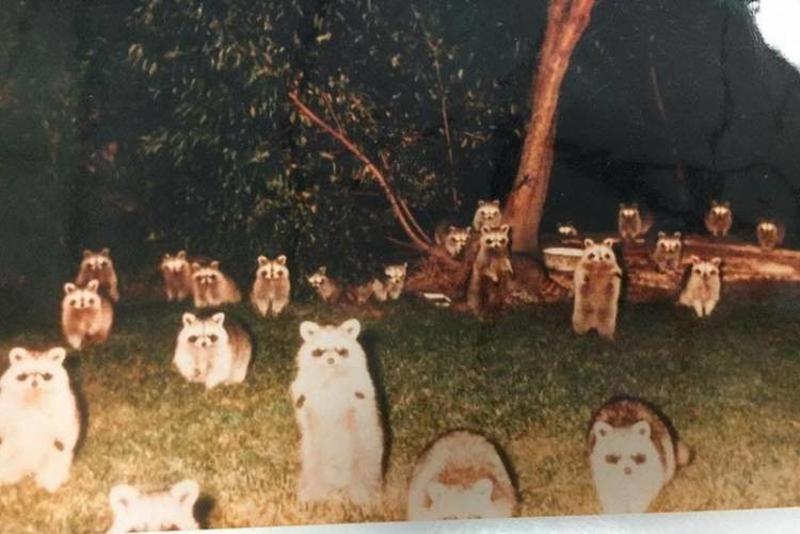
This is a veritable platoon of raccoons. They're scavengers and have a long history of breaking into tents and stealing any food they can find with their surprisingly nimble hands; they've been known to open bottles and sealed containers when provided with the opportunity. They're generally thought of as solitary animals though, hunting either alone, or in pairs. Obviously, this gang never got the memo! The photographer more than likely had left parts of her evening meal outside the tent, with would have attracted raccoons as surely as moths to a flame.
We've always assumed that everybody would have the exact same reaction to seeing a tornado; especially one of this size, which is a swirling column of destruction towering high into the sky. That reaction would be to grab your most important and valuable items, lock up your house, and either run or drive in the opposite direction as fast as you possibly can. Audra Thomas, a resident of Nebraska, apparently doesn't think along those lines. Instead, she thought it was a perfect photo opportunity.

Her calmness about the situation is probably a product of being from Nebraska; this won't have been the first tornado she ever saw, and the folk who live down that way tend to know how far away a tornado is, how long they have to run away from it, and which direction it's coming in. That twister looks like it's a field away from Audra at most, but when the shot was snapped, the distance was actually over a mile.
Even for meat-eaters, bacon and pig products are something of a quandary. We know that pigs are highly intelligent animals, who've displayed evidence of self-awareness and an understanding of cause and effect, but at the same time bacon is delicious. Not every pig ends up as bacon though; many live out long and happy lives. We're not sure if this pig was one of them, but he certainly did everything he could to achieve his freedom!

We have absolutely no idea how he managed to escape the livestock truck; we didn't know pigs could climb or jump, but this brave soul appears to have done both. His friends, still inside the truck, seem to be gazing on at him in wonder. We're pleased to say he survived the fall, was rescued by the local police force, and was adopted by the police. He now lives at a police station in a shelter usually reserved for police dogs!
So, let's pretend you're running for President. It's 1912. You need to work on your public image, and you want to get something out there in the press which just screams 'future leader'. There won't be any such thing as televised Presidential campaigns for at least seventy years, and social media won't be an option for almost another century. So, what do you do?

If you're anything like President Theodore Roosevelt, you have the New York Tribune run a picture of you bravely crossing a flooded river on the back of your pet moose. It's not as bizarre as it sounds; the moose was the symbol of the Progressive Party, who Roosevelt stood for. The most amazing thing, though, is that it's fake. An expert from the firm Underwood and Underwood painstakingly cut around a picture of Roosevelt on horseback, stuck it onto a picture of a moose in a river, and reprinted the composite image. Everyone fell for it. It's not just the Millennials who use filters!
If you suffer from arachnophobia, look away now! The usual process for a female spider having babies is to lay their eggs within in egg sack, wrap it up, and then let nature take its course. The strong ones will survive, and the weaker ones won't. Wolf spiders are a little more maternal and caring than most of their kind, though.

Female wolf spiders are the only known type of arachnid who carry their young around on their back. The egg sack is attached to her abdomen, and when the eggs hatch (which can be anywhere between one and four weeks), the baby spiders crawl up onto their mother's back and stay there until they're strong enough to survive on their own. Look how many little spiders this lady is carrying! Also note her expression. Anyone who has children of her own and has endured difficult family outings can sympathize with her here.
Be honest. Did you think we'd accidentally uploaded a picture of a naked woman swimming until you scrolled down and saw the fins? This is not a woman in the water. It's also not Ariel from The Little Mermaid, or photo trickery. It's a picture of a Beluga whale swimming towards the surface of the sea.

In days gone by, sailors stuck on boats crossing the ocean for weeks or months on end reported sightings of mermaids; mythical creatures which were part woman and part fish. It's highly likely they were actually seeing part of these unusual creatures in the water. Beluga whales have taken a different evolutionary path to most of their kind; they're almost white in color, and as you can see here, their bone structure resembles a pair of human legs if you look at it from the right angle.
There are two pressing questions that spring to mind when you look at this picture. The first is 'How on earth has an elephant fallen down a manhole?', and the second is 'How is anybody going to get him out of there?' The answers are fairly simple, it fell down there because young elephants are incredibly clumsy, and he got out again with the help of some rope, a team of human rescue workers, and a lot of physical effort!

Although they reach a huge physical size in a relatively short space of years, an elephant isn't considered to be an adult until it's around 20 years old. Before that point, they have even less grace than they do when they're fully grown, and are prone to falling over, running into things and generally getting themselves in a fix, like this little one did.
Crocodiles are fairly scary by default. They're savage, they have powerful jaws that could bite straight through your limbs without a hint of trouble, and they're usually over six feet long. From our point of view that means they're already frightening enough, and we were happier not knowing that there are also super-crocodiles out there in the wild somewhere!

The gigantic specimen we see in this picture is an exceptional one, though. The image comes from Queensland, Australia, in 1957, and shows Polish crocodile hunter Krystina Pawlowski proudly posing with her latest trophy; an enormous crocodile that measured 28 feet from nose to tail. Pawlowski's 'one shot' nickname stems from the fact that she killed the beast with a single shot. Over sixty years later, Pawlowski's crocodile remains the largest ever recorded, and she's an official Guinness World Record holder.
Despite what you may have read on internet forums, or seen in movies, bears do not make a habit of attacking humans. They'd rather we just kept out of their way, and they'll stay away from us. Very rarely has anyone been attacked by a bear without doing something to provoke it, but it's best to avoid getting too close to them, all the same.

Unfortunately, getting too close to them is a regular accident in Alaska. Nobody told the bears that humans want to share the State with them, and so they'll occasionally come and defend their territory if we wander too close to the places they live. In those situations, it helps if you have something handy to make your escape with; for example, a bike. We bet this cyclist broke his 'Personal Best' records on this day!
If you've seen the movie 'Rocky', by which we mean the first of the seemingly endless saga, you might be aware that the film is semi-biographical, depicting some of the true events that have happened in the life of Sylvester Stallone. If the movie was art imitating life, Stallone flipped it back around to life imitating art when filming wrapped.

In the film, Rocky buys two tiny turtles from a pet store as an excuse to speak to future wife Adrian, who worked there. Stallone fell in love with the babies for real, and so he decided to keep them. Amazingly, they're still alive today, at the age of 44! Turtles can live up to 200 years in the wild, although they tend to do less well in captivity, where their life expectancy is more likely to be 30-40. Stallone must be doing an incredible job of caring for them.
Most people will have seen 'Jaws', the tale of a shark hunting human beings on the open waters. The idea of being stalked by a shark and left helpless when it comes to take a bite out of you, is a thought that's surfaced in all of our minds whenever we've gone for a dip in the sea. Be glad it's only modern sharks you have to worry about though; just look at the size of the jaws on this Megalodon!

The Megalodon is extinct nowadays, but to give you an idea of how enormous it was, the shark seen swimming away from its jaws here is a great white, presented in scale. The prehistoric monster was sixty feet long, and when it clamped its jaws down, it did so with an equivalent force of 40,000 pounds. If it were still alive today, it would be the strongest creature on Earth by some distance; and we'd also probably never have started travelling by boat, in fear of meeting one!
There's a lot going on in this picture. We have a dingo eating the beached torso of a shark, whilst apparently watching two snakes mating. Is the dingo a voyeur? Did seeing a shark being eaten put the snakes in the mood for some romance? What were the chances of going out for a walk and actually stumbling across this scene?

Actually, the chances were close to zero. There's some photographic trickery going on here; two different pictures have been merged together and entered into a competition to find a photo that sums up Australia. That doesn't take away from the fact that in the Land Down Under, sharks wash up on beaches and get eaten by dingoes, though, and we think that's pretty remarkable in its own right! As for the snakes; they're just having a good time. Leave them to it!
Mountain goats are called mountain goats because they're capable of climbing mountains. But did you know they could also climb trees when the situation calls for it? Now you do, and you have this picture as evidence. This is a genuine image, taken in Morocco. It's not the goats that are unusual here though; it's the tree itself.

Specifically, this is an Argania tree. It produces a type of nut which, whilst uninteresting to humans, goats go wild for. If there's a nut on the farthest branch, at the very top of the tree, you can bet a goat will still try to reach it. Goats hang around in herds, so when one of they see one of their friends start climbing, the rest are bound to follow. Whilst their position may look precarious, they're surprisingly agile creatures, and none of them are in any danger of falling off.
Most people know the story of the ancient city of Pompeii in Italy, which was buried under volcanic ash and frozen in time when Mount Vesuvius erupted. Fewer people are aware that Vesuvius is still an active volcano. It's erupted several times since then and could still in theory go off on any day and bury the towns around it all over again. Isn't that a cheerful thought?

In this picture, the volcano is throwing out a small eruption in 1944, during the Second World War. A US Army Air Base was stationed close to the volcano, and several planes were damaged by ash, molten rock and other debris. The more alert pilots got their planes into the air to avoid the eruption though, and they were able to take incredible photos like this one. It's bad enough having bombs dropped on your city during a war, never mind nature rebelling against you at the same time!
This photograph of an enraged bear entering a tent is incredible, but unfortunately there's a sad and tragic tale behind it. The picture was taken in 1996 by the Japanese photographer Michio Hoshino, who was a master of his craft and had won many awards for his skill at his chosen profession. His specialist subject was Russian and Alaskan wildlife, and he'd gone on a trip to Russia to take a fresh portfolio.

This was the last picture Hoshino would ever take. The bear charged into the tent and mauled him to death. Before it did, he was able to point his camera at it. The camera survived the attack, and the film was developed some time later, revealing that Hoshino had been able to capture the image of his killer in his final moments. Brown bears in particular rarely attack humans, and the belief is that this was a mother, acting out of protection towards its children.
Here's a dog facing a quandary that none of us would welcome. The skunk is eating his food. By rights, he should attack the skunk and drive it away, but it surely knows that the skunk will respond by spraying him with its foul odor. He's taken the wise route and decided to sit back and let the skunk finish its meal instead, in the hope that it will leave something for him.

Not all dogs are as clever as this one; in some parts of America, curious dogs get sprayed by skunks so often that manufacturers of pet products have had to create special shampoos to help get rid of the stench! Look how angry the canine is about all of this, though. You can just see in its eyes that it's already planning its revenge.
In the olden days, before the existence of photography, people just had to trust their elders when it came to stories about the past. So, if someone was ever sat with their great grandfather, listening to him tell tales about the day a tornado so big that it filled the entire sky came to town, they would probably think there was a pinch of exaggeration to the tale.

Photography was still in its infancy in 1898, but it had developed (if you'll excuse the pun) to the point where you could capture live events happening so long as you could hold the camera in position for a while. Here's an unbelievably huge tornado that ripped through Waynoka, Oklahoma that year. Note how calm the people stood in the road are, as they gaze up at the sky with their hands on their hips. That wouldn't be us. We'd be running in the other direction as fast as we possibly could!
Whilst at first glance this may appear to be an alien creature, or a monster from the darkest corners of your imagination, it is in fact a simple hermit crab who's made an unusual choice of home. Hermit crabs live inside shells but aren't born with their own. That means they have to scour the environment around them and make use of whatever they come across.

As the crabs grow, they need larger and larger shells in order to remain comfortable. A human shell is a good size for a hermit crab, and so this one has probably settled down for life; unless it comes across another hermit crab. Because shell space comes at a premium, the crabs will do battle over prime real estate, with the winner walking away with the prize. The real question here, though, is whose skull is that, and why is nobody investigating it?
Although your initial impression might tell you otherwise, you are not actually looking at this mole from behind. That strange, pink feature right in the middle of the creature isn't its backside, or a spider that's dropped onto it from above. That is, in fact, its face! This is a star-nosed mole, which got its name for obvious reasons, and you can find it in the wetter parts of the very north of North America.

The tentacle-like pink legs coming from around its nose are called 'Elmer's organs', and are incredibly sensitive, serving a similar function to a cat's whiskers. They can detect changes in temperature, sense distant vibrations (thus alerting the pole to predators), and of course follow the trail of any smell over long distance. The creature is never going to win any beauty contests, but it would be aware of a gas leak long before you!
Have aliens invaded? Has this photo been taken on the set of the next big science fiction movie? No. We're back in Nebraska again; a part of the world that sees extreme weather on a regular basis, and where the residents are a little more accustomed to unusual sights in the sky. These clouds are actually the aftermath of a tornado.

The clouds are known as 'mammatus clouds', although some people just go straight on-the-nose and call them 'mammary clouds'; they get their name because they're thought to resemble the udders of a cow. They're an interesting phenomenon to look at from the ground, but in the air they're potentially hazardous to pilots, because their formation creates downdrafts and pouches of warm air. As well as accompanying tornadoes, they've also been observed to appear after volcanic ash is thrown into the atmosphere following an eruption.
Bald eagles are the apex predators of the skies. Whilst a lot of birds will descend to the land to find something tasty to eat, eagles are big enough just to pick off other birds and take them home for dinner instead. That's exactly what's happening in this picture; it's seen a passing seagull, decided it's just the right size to fill its appetite, and gone in for the kill.

The seagull's luck might be in though; one of its friends has seen that it's in trouble, and it's come to lend a hand. Sadly, we have no idea whether it was successful or not. Given the lack of evidence, we'll just choose to believe that the seagull survived, the eagle was sent packing, and that this was a dramatic tale of risk and rescue in the skies.
Who was in charge of health and safety here? This isn't a stuffed tiger, or a fake tiger, that's a real-life tiger diving headlong through a kitchen window on the set of the 1981 movie 'Roar', The woman in the image, backing away from the danger, is Tippi Hedren. She starred in the film, along with Gregory the tiger, who was her pet. If you've never heard of 'Roar', then rest assured it's the sort of picture that would never be made today.

The premise of the film was an American family moving to Africa to see a famous veterinary scientist. CGI wasn't an option to create the animals back in 1981, and puppet work would have been obvious, so they went with a cast of real animals who were supposedly tame. You can probably guess how this story ends; 70 people who worked on 'Roar' received injuries from animals, and some of those injuries were severe, including a scalping.
Pandas are rare enough at the best of times; it's doubtful they'd still exist at all were it not for human conservation efforts. This panda is even rarer than the rest of its species though; it is, in fact, the only brown panda in the world. There's technically no such thing as a brown panda; the coloring in the case of this gentleman, whose name is Qizai, is a genetic mutation.

Qizai didn't have a happy start to life when he was born in a Chinese forest. His mother rejected him as a baby (presumably because he was the wrong color), and so he was left to fend for himself. He wouldn't have survived had humans not found him and taken him to safe location full of other rescue pandas in the Foping Panda Valley. Qizai has grown up healthy and happy, and his carers are now hoping to find him a mate.
If this photograph had been a painting, it would be considered a masterpiece. The photographer clearly has an eye for a dramatic shot, and in this one they've captured angry skies above the roads of Moscow, just as the sun is beginning to set.

The dramatic range of colors and the ragged pattern of the cloud suggests one of two things; either the city as just been visited by a storm, or there's one on the way. We think it would have been extremely windy when the photo was taken! With clouds of various shapes and sizes appearing both high and low in the sky the fading sunlight bounces everywhere, producing a truly breathtaking scene. The atmosphere the photo creates is almost intimidating; the sky looks wild and foreboding, as if it were a harbinger of a future apocalypse. In reality, though, it was probably just another we Tuesday in Russia's capital.
Well, how can we dress this one up. There are no prizes for guessing what this creature is called. Can you figure it out? That's right, it's the atretochoana eiselti. We're kidding; that's its scientific name. Everybody else in the world calls it the penis snake, and it's entirely obvious where it gets its name from. If you uploaded this picture on social media, you'd probably get your account suspended!

If you're laughing at the penis snake though, be aware that it's also laughing at you. It's not actually a snake at all; it's a limbless amphibian, rather than being a reptile. Not only that, it's the largest tetrapod that doesn't have lungs; it absorbs oxygen through its skin. For over a century, the only known examples of the species were two samples that explorer Sir Graham Hales brought back from Brazil in the 1800s, but more recently we found it again in the wild, in 2011.
Manta rays are fascinating creatures. We find them cute because they appear to be smiling, and they're very tame. If you've been to an aquatic center, you may have seen a pool of these fish, which will eat from your fingers if you hold a little food for them below the water. Rays that are used to being fed this way may even slap their fins on the side of their tanks, demanding that you feed them! You'd probably need an Olympic swimming pool to house this one, though.

This is the largest manta ray ever recorded. That's not to say there aren't even bigger ones beneath the waves; it's just that this one was unfortunate enough to get caught on a boat's anchor line, and so was dragged out of the water, giving someone the chance to measure it. When they did, they found it measured 20 feet across from fin tip to fin tip and weighed an incredible 500lbs.
Do you think you've ever seen lightning like this before? Allow us to save you the effort of thinking about it; unless you've been to a very specific location in Venezuela, you haven't. This unusual sky phenomenon is known as Catatumbo lightning, because the only place in the world it happens is above the Catatumbo River in the South American country.

A perfect storm of contributing factors is responsible for the lightning happening in this way; the area is surrounded on three sides by mountains, meaning air picks up electrical charge as it climbs upwards, and then discharges it over the bogs surrounding Maracaibo Lake. The locals must be used to it; the lightning happens on an average of 150 nights each year, and when it does, it can go on for as long as ten hours, with 250 lightning strikes in each of those hours. Nowhere in the world sees more lightning more regularly than the Catatumbo River.
Next time your cellphone signals suddenly dies or drops off, and you're about to complain about it, take a second and think about whether there's been any freezing weather recently. If there has, whilst it's still an inconvenience, you should probably spare a thought for the unfortunate souls who are facing a task like this to fix the problem for you.

This isn't an Arctic climber attacking a wall of ice; this is a technician climbing up a frozen cell phone tower to try to shift some of the ice away and get everything working again. Cell phone towers tend to reach significant heights, where the air is colder, and so adverse weather affects them more than anything on the ground. With the wrong combination of high winds and snow, frozen water can become an icy spear, sailing through the air until it finds something to wrap itself around and cling on to.
It takes a brave and hardy soul to take a fishing boat (or a boat of any kind, for that matter) out onto the waters of Lake Michigan. One of America's five Great Lakes, the body of water has a major impact on the type of weather that citizens of Chicago experience; and it isn't a particularly positive one! Unless, of course, you mean the positive charge of the electricity that routinely shoots down into the water.

Lake Michigan isn't really a lake; it's a small sea, composed entirely of freshwater. Thunderstorms love freshwater; they can draw from them, ripping away electrical charge and powering up the clouds. In short, Lake Michigan is lightning fuel, and anybody who lives close to it is liable to get burned! The photo itself is the product of fortunate timing; five separate strikes wouldn't be visible to the naked eye, but in the split second the shutter went off it captured them all perfectly.
If you stay on top of the latest viral images on the internet, you might have seen this one doing the rounds last year. It's a battle to the death between two snakes, in which both of them lost. They should probably just have shaken hands and called it a draw, but as they don't have hands, we guess they were stuck!

There are two ways can kill any prey (including humans); either a venomous bite, or by constriction, whereby the snake will simply squeeze and squeeze until blood can no longer circulate. Here we have a python, which uses the constriction method, fighting a king cobra, which prefers to bite. We don't know who started the fight, but the python has wrapped the cobra up and strangled it to death, whilst the cobra has poisoned the python in an attempt to get free, and the python eventually succumbed to the dose. No winners, only losers!
We're so used to seeing light, white fluffy clouds; or alternatively heavy gray ones; that it now creeps us out a little when we see anything that deviates from that norm. Take these disc shaped clouds for example; they look like they've been made by hand and spun into shape. Also, is it us, or do they look like they're riding on the back of a dolphin?
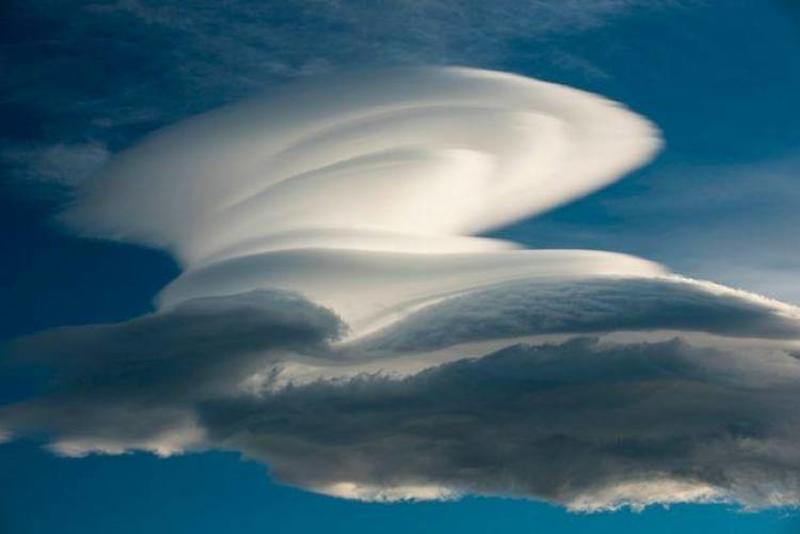
In the past, lens or disc shaped clouds have been responsible for false reports of UFOs, and you can understand why; to the untrained eye, and on a dark night, they might look like flying saucers. Here's the science; a lens shaped cloud forms when a normal crowd blows across the top of a mountain, thus disrupting the flow of air within the cloud. Moister, stable air rushes into the gap, and then condenses to form a flat cloud, which wind then turns into this distinctive shape.
This has to be Photoshop, right? Wrong. This gigantic 50ft high block of ice, which is even longer than it is tall, is a permanent feature of the Antarctic. You expect almost everything in the Antarctic to be frozen over with ice and snow, and technically this solid lump is too; it's just doing something unusual with the light to give off its blue appearance.
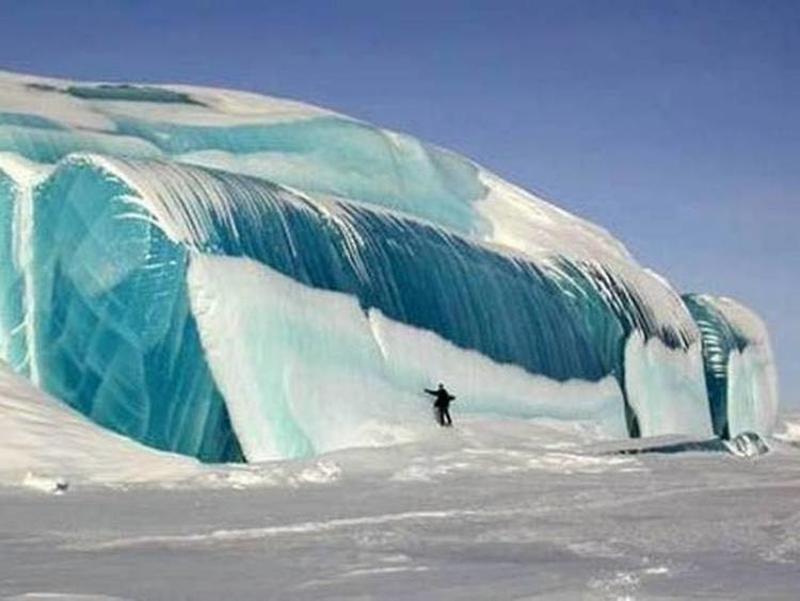
The giant structure is actually made up of tightly compacted ice, full of frozen bubbles of air, and it's incredibly dense. Even light can't make it all the way through; the wavelengths of light that allow us to see the color red are completely absorbed by the frozen behemoth, meaning that we see it as a rich and deep blue. It's unknown how the monolith was initially formed, but it's still growing; every year in Winter, more and more layers are added to its outer shell.
If you had to take a guess as to what type of big cat you were looking at here, we think most of you would either say an especially black cheetah, or an especially black jaguar. You're not far off with the second guess, but this isn't technically a standard jaguar at all; it's a unique species in its own right called the black jaguar, and it's one of the rarest animals in the world. With its rich golden highlights and deep, dark black spots, it's a regal creature to behold.

That's not to say it isn't related though; the species has a lot in common with not only regular jaguars, but also leopards and panthers. That means that however attractive it is to look at, and however much you might want to stroke it, we wouldn't recommend trying to do so. It's a very fast and very powerful hunter, and it might decide you look tasty.
There's a little bit of controversy about this one, so we're just going to take it at face value, explain what you're seeing, and let you judge for yourself. This photo, taken by Darren Pearson, allegedly shows the path of a lightning bolt striking a tree and dissipating through the roots as the tree absorbs the shock. Pearson claims that he took the image on a long exposure, and therefore was able to chart the flow of the electricity through the tree.

If he's to be believed, then what we're seeing is a purple-white hot glow in the center of the tree as the bolt first strikes it, which then fades to blue as the charge passes down into the roots, before fading out completely. It seems incredible that a tree could survive such a blow, but they do it routinely. Many critics on the internet have suggested that the image is fake, and the details of the strike have been added in using Photoshop or other photo manipulation.
Depending on whether you're talking to a cat lover or a dog lover, each will tell you that their own pet is cleverer than the alternative. Dog owners will point to the fact that dogs can be taught tricks as evidence that they're more intelligent. Cat owners will tell you that cats are above doing tricks for your entertainment, and just don't do it because they don't see the point. This picture might settle the debate.
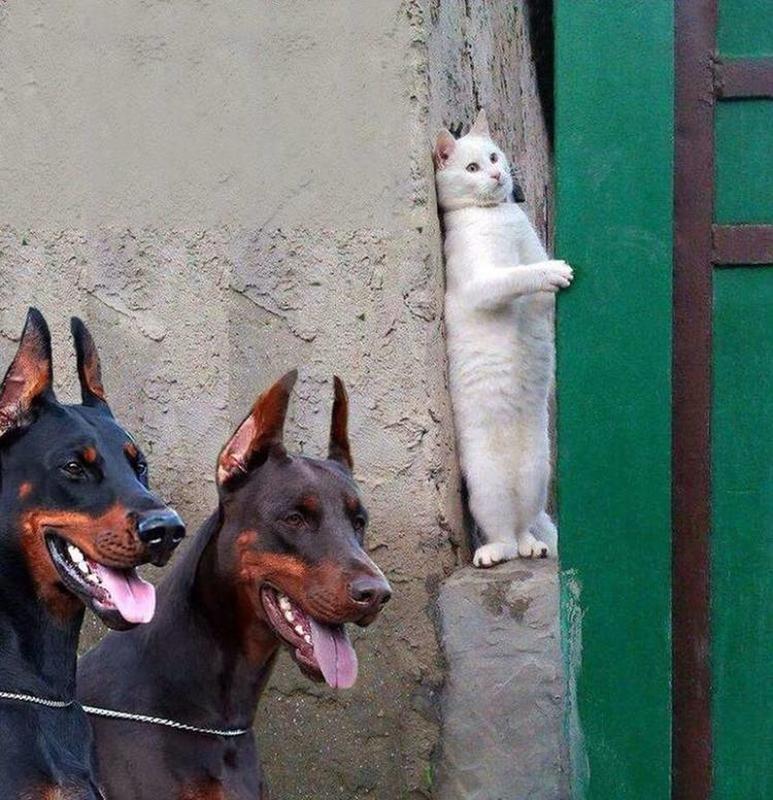
The two dogs we can see here are Dobermans, who are a lot less scary than they actually look. They're often used as guard dogs, and they can definitely bite if provoked, but their nature around humans, other dogs and even cats is generally pleasant. This crafty cat is taking no chances though; it's found a hiding place and it's going to stay there until they're gone!
If you're having trouble identifying the species in this picture, it will be because unless you're well over 100 years old, you've never seen this animal before. It's a family portrait of a group of Tasmanian Tigers, taken a zoo in Hobart in 1910. Regrettably, this distinctive and unique creature is now extinct.
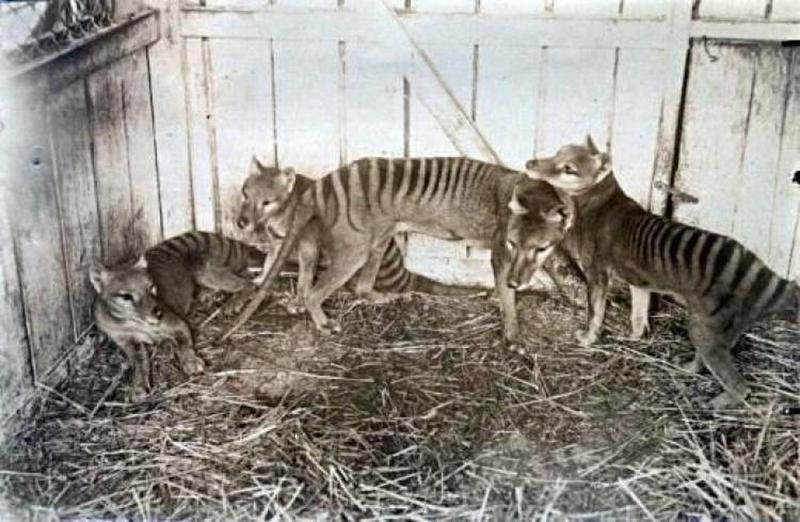
The creature, also known as a thylacine, had the build and stature of a wolf, but the stripes of a tiger. Much like a fox, it was a stealthy and shy animal, which preferred to do its hunting at night. Once upon a time they were common in Australia, New Guinea and Tasmania, but a combination of disease, hunting, loss of habitat and attacks by domesticated dogs did irreparable damage to the numbers of Tasmanian Tigers in the early 20th century. At some point over the course of the 1900s, we lost them forever.
If you're a carnivore, life in the ocean must sometimes get a little dull from a culinary point of view. Most of us enjoy a good piece of fish to eat on occasion. Fewer of us would be happy with the idea of eating fish every day of the week for the rest of our lives, but if you're a water dweller you don't really get the choice!
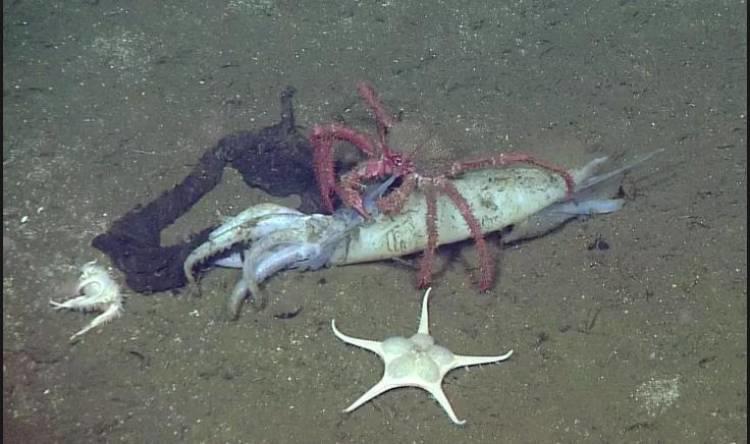
In this image, a dead squid is providing a feast for not only a crab, but a couple of starfish. Because we usually associate starfish with being cute, fluffy and lovable because of their shape, we tend not to consider the fact that they might eat other living creatures, but they do. As well as any fish carrion they encounter, they'll also go looking for snails and sea urchins, among other snacks.
The purpose of sailboats is an obvious one; using the power of wind in their sails, they move across the water from destination to destination. The water is crucial in this equation. They're significantly less good at moving through ice, as Sir Ernest Shackleton and his ship, the Endurance, found out in 1915.

It had been a bad trip for Shackleton to begin with; he'd been beaten to the South Pole by Roald Amundsen and his team. On the return home, the Endurance became trapped by packed sea-ice, which eventually lifted the ship clean out of the water and froze it in place, as we can see here. Amazingly, the crew survived by camping on the ice for 18 months before jumping on life rafts in desperation, eventually reaching an inhabited island. The Endurance had no such luck; eventually the density of the ice became too much for it, and it was destroyed by the crushing force.
The conventional advice you'll find with regard to approaching polar bears is "don't do it", usually followed by the word "ever.". They're incredibly powerful animals, more than capable of tearing a human being apart limb from limb. However even a polar bear isn't averse to accepting help when it desperately needs it; it just takes a very brave person to try. Fortunately for the mother bear and her cub in this picture, Russian soldiers aren't short on bravery.
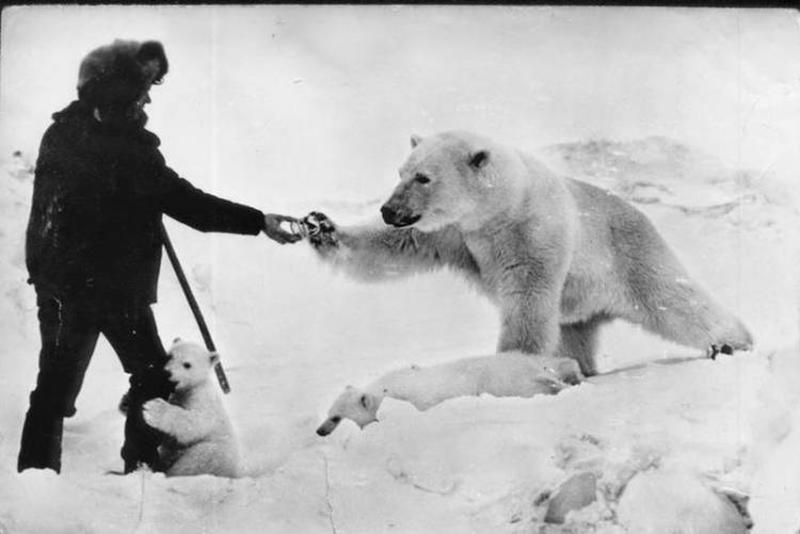
In the Chukchi Peninsula, temperatures can drop to 25 below zero, and hard ice can form over the snow, making it impossible for polar bears to dig through it and find food. The bear and her cubs were slowly starving. The soldiers had a plentiful supply of condensed milk, and it was enough to keep them alive. Normally, a polar bear protecting its young will attack anything it perceives as a threat; it must have somehow realized these men only wanted to help.
There's a particular school of thought among internet-based conspiracy theorists, which says that long, thin strips of cloud in the air are actually 'chem-trails; the residues of chemicals that Governments spray on their people in an attempt to somehow control them. In reality, they're just unusual cloud formations, sometimes caused by the effect of planes passing through cloud at high speed.
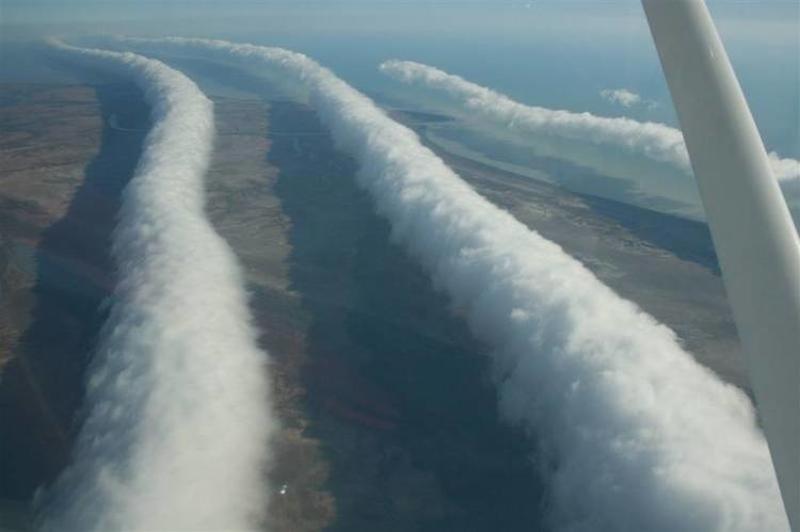
These particular trails of cloud are an all-natural creation though. Nicknamed 'morning glory cloud', they appear regularly in Northern Australia, where a combination of temperature and wind turns clouds into rolls, taking on the appearance of long cigars. They're such a common sight in this part of the world that they've become a tourist attraction; especially during Fall months, where they occur most regularly. Some companies have even started up, offering visitors to go up into the air on a glider and sail through them!
On a land mass as wide as the United States of America, wind has plenty of opportunity to pick up pace until it becomes a tornado. When that tornado happens over a populated area, the effects can be devastating. In the skies above the State Capitol building on the 4th of May 1922, a rare and freakish occurrence wreaked havoc on the land down below.

This incident still remains the worst tornado ever to hit Austin, Texas. Moments after this photograph was taken, the single column tornado seen in the sky split into two, with the twisters heading off in different directions and tearing up everything in sight. The roof was torn clean off a student dormitory at St. Edward's University, and many public buildings were severely damaged, with serious injuries and loss of life reported. You can make buildings with the strongest materials possible, but nature can still tear them down if it really wants to.
Unless you've taken a trip out to the Arctic, which is an activity we'd recommend only for seasoned explorers, you won't have seen one of these animals in the flesh. Seemingly half goat and half rabbit, this fluffy and friendly looking animal is the arctic hare. As you can see, it has all the features that it needs to survive and thrive in such an inhospitable landscape.

The arctic hare is something of a chameleon. During warmer months it has brown fur, but when winter comes it goes completely white, helping it to blend in with the world around it, and thus becoming harder for predators to see. Its paws are padded and ridged, like having hiking boots on, and its unusual body shape is perfect for retaining heat. When they crouch down to sleep, they look like giant snowballs. It's easy to see why they're sometimes called polar rabbits!
If you're unfortunate enough to have experienced a tornado, we imagine you didn't waste much time wondering why there wasn't any lightning along with the tornado; you'd have been too busy either running away or finding somewhere to shelter. It's a fair question though; lightning comes with every other type of storm, so why would a tornado be any different?
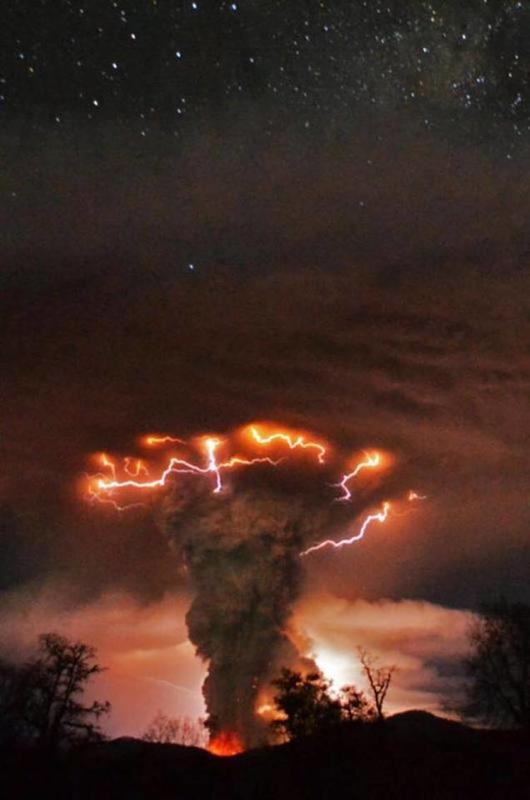
The answer of course is that it isn't, as we can see here. The unique atmospheric conditions created by a tornado mean that the lightning just never reaches the ground. Instead, it shoots from cloud to cloud, crackling and fizzing across the sky, often difficult for the human eye to pick out, but obvious to a camera lens. The energy charge from the lightning actually feeds the tornado and helps it to keep spinning. That's the last thing anyone needs!
If you saw this coming over the horizon, you'd be inclined to give up and just accept your fate. One tornado is difficult enough to deal with. Seven at once would surely consume everything in its path and leave nothing in its wake but broken wreckage. Fortunately for the person who created this image, that isn't really what we're seeing.
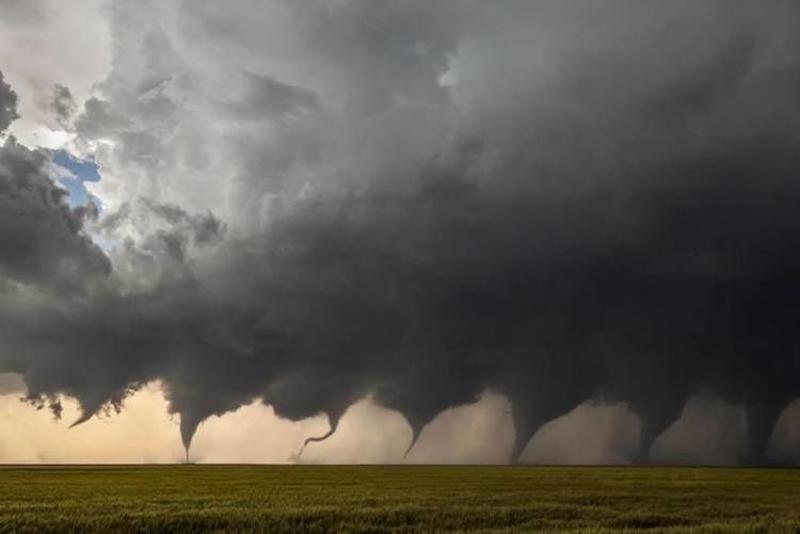
This is actually a time-lapse photo, showing the same tornado being formed. It starts out life as a funnel cloud before connecting to the ground, and then picking up shape and speed as it becomes a full-blown twister. Even though it looks huge and powerful in its final stage, this is a comparatively small tornado which probably didn't represent much in the way of danger and will have blown out quite quickly. That's probably why the photographer felt safe to stay there and record the entire event.
From a very early age, we're told never to take anything electrical into the bath. It used to be the case that every now and then someone would electrocute themselves when their radio fell into the bathwater; more recently it's happened when people have tried to charge their phone whilst in the bath, and had the connected charger fall into the water. The long and short of it is that electricity and water don't mix!

This photograph is an excellent demonstration of the reasons why. The water conducts the electricity across its surface. Fish instinctively know this, and so during a storm they'll swim deeper into the sea, where they're safe. For humans out swimming, or boats on the water, it's a different story. Lightning strikes like this one contain up to 300 million volts, which would be instantly fatal for anyone it touched.
Very few things on our planet attract as much legend, folklore, myth and outright fascination as the pyramids. The ultimate achievement of Ancient Egypt, they've stood in place for thousands of years, and we still can't say for sure how anybody could possibly have built them. Inevitably, that leads to some people believing it must have been aliens.

If it was aliens, they'll have come from that incredible field of stars above the landscape, captured on an exceptionally clear night sky. We call our galaxy the Milky Way for obvious reasons, and the Egyptians thought of it in similar terms. In the legends of the Ancient Egyptians, the milky pattern across the sky literally came from cow-headed goddess named Bat, who was the god of fertility. The real, but less interesting, reason for the appearance of the milky pattern is that the sky contains millions of stars, packed so tightly together than they appear to form one whole pattern, dusty and sparkling.
You'll have to look at this perfectly-angled picture twice to understand what's really going on. It's not two pictures stuck together; it's all one image, and the scenery is one hundred percent real. The car is driving down the road in front of a perfectly tranquil and flat lake, which provides the illusion of an area of sky in front of the road. The lake rolls on towards the mountains, which dominate the skyline, shooting up through the mist.

Unfortunately, we haven't been able to find out precisely where in the world this is (although anywhere with large mountains would be a good place to start). It looks like the most picturesque drive you could ever imagine and proves that nature will always provide better backdrops than a Hollywood movie will ever create, no matter how advanced technology becomes.
How could we resist showing you another Egyptian skyline when it looks as good as this? In the foreground is the Great Pyramid of Giza, the largest and most spectacular of them all, and the final remaining Wonder of the Ancient World. Before it, and perfectly aligned as if it had been positioned there as a guard, is the Sphinx. Note how perfectly it lines up with the center of the Pyramid. That's no accident; the Ancient Egyptians were skilled with geometry and knew exactly what they were doing when they positioned it.

The sky is the real star of the show though. The photo has been taken as the sun is going down in Cairo, and the Pyramid seems to filter and split the light, turning it into individual beams which shine across the sky. With views like this, it's easy to understand why Giza was such a sacred and special place to the people of the time.
Water doesn't come in slices. If you have a glass that's half full of water, and then go on to fill it with more water, the result is a glass full of water. There's no way of knowing which part of the water was in there to begin with, and which part has just been added. It all blends together. Isn't that how water works?
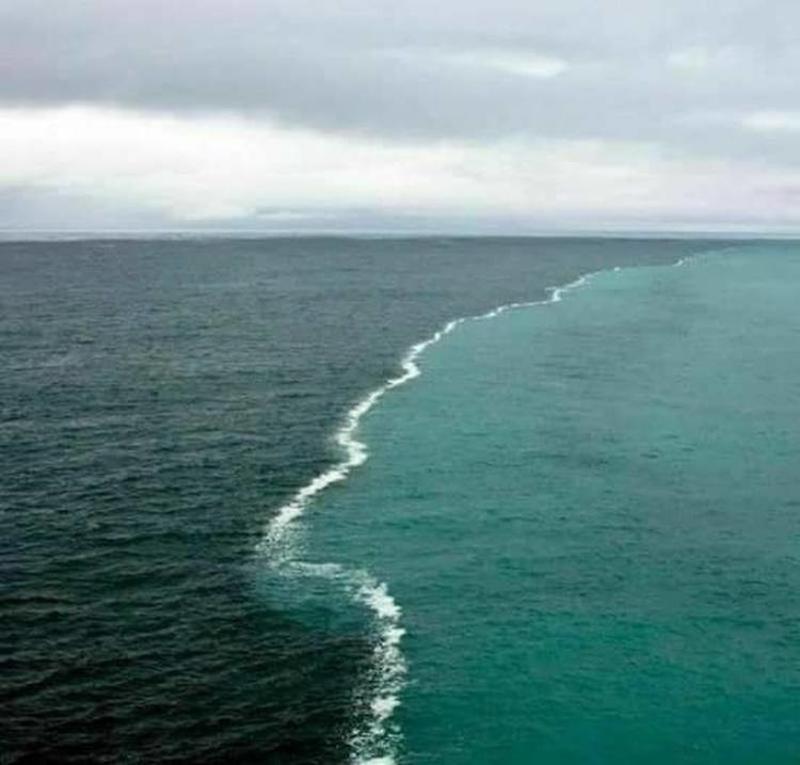
Actually, not always. What you see in this picture is two forms of water that are just too different to merge. The lighter blue water is fresh water, running off a melting glacier, whereas the darker blue sea water of the Gulf of Alaska is denser and saltier, and therefore can't mix together with it. As a result, the sea stands at an impasse, marked by a frothy white line where the two types of water clash and rub together.